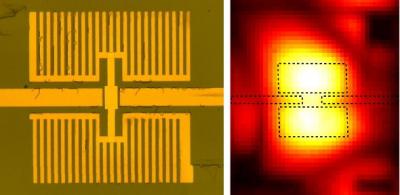Researchers from the Graphene Flagship, working at the University of Cambridge (UK), Emberion (UK), the Institute of Photonic Sciences (ICFO; Spain), Nokia UK, and the University of Ioannina (Greece) have developed a novel graphene-based pyroelectric bolometer - an infrared (IR) detector with record high sensitivity for thermal detection, capable of resolving temperature changes down to a few tens of µK. This work may open the door to high-performance IR imaging and spectroscopy.

The technology is focused on the detection of the radiation generated by the human body and its conversion into a measurable signal. The key point is that using graphene, the conversion reaches performance more than 250 times better than the best sensor already available. But the high sensitivity of the detector could be of use for spectroscopic applications beyond thermal imaging. With a high-performance graphene-based IR detector that gives a strong signal with less incident radiation, it is possible to isolate different parts of the IR spectrum. This is of key importance in security applications, where different materials explosives, for instance can be distinguished by their characteristic IR absorption or transmission spectra.
The graphene-based devices consist of a pyroelectric substrate, with a conductive channel of single-layer graphene and a floating gate electrode placed on top. In pyroelectric materials, changes in temperature lead to a spontaneous electric field inside the material. The floating gate electrode concentrates this field on the graphene, and the field causes changes in the electrical resistance of the graphene, which are measured as the device output. Typical IR photodetectors operate either via the pyroelectric effect, or as bolometers, which measure changes in resistance due to heating. The graphene-based pyroelectric bolometers combine both effects for excellent performance and could be used as pixels in a high resolution thermal imaging camera.
The team explains that graphene acts as a built-in amplifier for the pyroelectric signal, without needing external transistor amplifiers like in typical pyroelectric thermal detectors. This direct integration means that there are no losses and no additional noise from connections to external amplifying circuits. We can build the amplifier directly on the pyroelectric material. So, all the charge that it develops goes to the amplifier. There is nothing lost along the way, said the co-author of the work.
The use of graphene also offers benefits for further integrating the detector pixels with the external readout integrated circuit (ROIC) used to interface with the detector pixels and the recording device. To match the input impedance of the ROIC, you need something that is as conductive as possible. The intrinsic conductivity of graphene helps the further integration with silicon, said the scientists. Impedance matching is essential to ensure that the signal is transmitted as efficiently as possible. This benefit is unique to graphene due to its combination of high conductivity and strong field effect.
In August 2016, researchers from the University of Cambridge developed a high performance room temperature graphene-based mid-infrared photodetectors. Such graphene-based "bolometers" enabled the researchers to achieve ultra high performance - a TCR as high as 900%/K. The researchers hope that this device could in the future be used in astronomy, medicine imaging, automotive and even smartphone infra-red cameras.